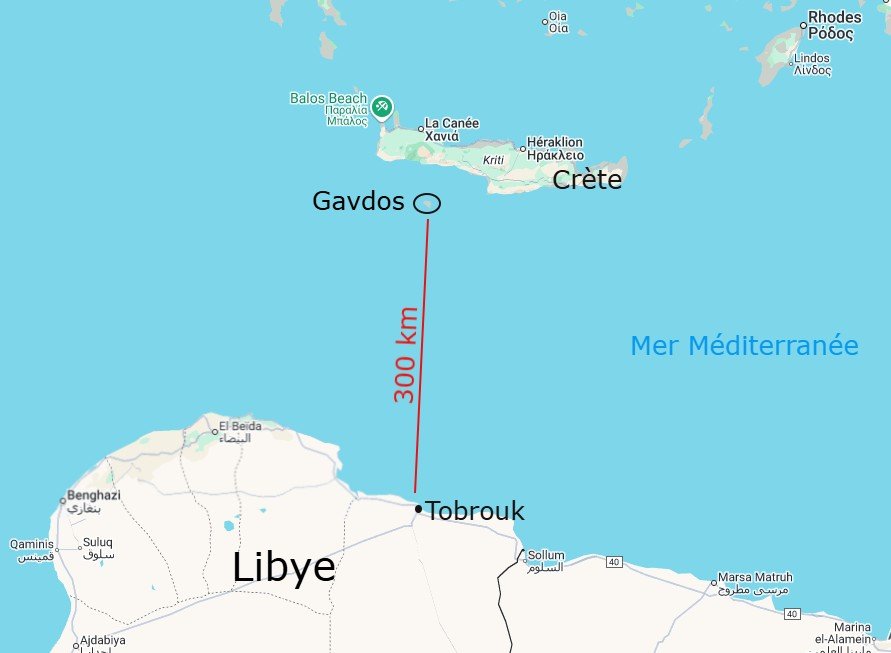The small island of Gavdos has seen a steady increase in the number of irregular arrivals, overwhelming residents. Authorities say that Gavdos risks becoming a "Greek Lampedusa" as irregular migration paths to Europe continue to shift.
At least three people died when their boat sank south of the Greek island of Crete, the Hellenic Coast Guard announced today (November 12).
In a statement on their website, the Coast Guard said that they received a request to assist a dinghy in the sea area south of Gavdos on Tuesday afternoon (November 11).
Frontex, the border management arm of the European Union, responded to the call for assistance. However, while nearing the dinghy to start the transfer of passengers, there was a reported "movement to its left side, resulting in the inflow of water and its overturning."
Lifeboats, buoys, and life jackets were immediately deployed. In total, 55 passengers, detailed as 51 men, one woman, and three minors, were reported to have been rescued, while three bodies (two men and one woman) were recovered.
The group of 55 who were rescued were transported to the port of Agia Galini, located on the nearby island of Crete, where they disembarked safely. One male passenger was transported by ambulance to the General Hospital of Rethymno for medical treatment, while the other 54 were transported by bus to a temporary accommodation facility in Agia Galini, Chania.
The remains of the three people who had perished were transferred to the General Hospital of Chania for an autopsy.
High number of irregular arrivals and rescues
Over the last ten days, the Greek Coast Guard has reported a series of search and rescue operations off the southern coast of Gavdos Island, in which dozens of migrants were brought to safety and three men were arrested on suspicion of migrant smuggling.

In the most recent operation, conducted on Monday morning, authorities rescued 28 people from a boat drifting south of Gavdos. A 33-year-old man from South Sudan was identified by other passengers as the individual who had allegedly organized their journey from Tobruk, Libya, in exchange for payment. He was arrested on charges of facilitating illegal entry under Greece’s migration and criminal laws.
The Coast Guard also confirmed earlier rescues in the same area on November 3, involving a group of 23 people and another group of 21 people. In each case, a man from South Sudan, one aged 18 and the other 25, were singled out by survivors as the alleged smuggler responsible for steering the boat from Libya. Both suspects face similar charges of facilitating illegal entry.
Read Also'Almost impossible to stop'?: Is the use of speedboats changing migration towards Europe?
Shifting migration paths
The tiny Greek island of Gavdos, located just south of Crete, has become a new entry point for migrants attempting the dangerous journey from Libya’s eastern coast, particularly from the port city of Tobruk, roughly 200 kilometers away.
In recent months, vessels carrying Egyptians, Pakistanis, Bangladeshis, and Sudanese nationals have reached the shores of Gavdos or nearby Crete, reflecting a shift in migration patterns across the Mediterranean.
The Libya-Greece sea pathway is reportedly a migration route riddled with smugglers operating out of Libyan ports. The route emerged as smugglers reportedly adapt and re-route in response to tighter surveillance and crackdowns along the central Mediterranean passage to Italy.
More than 60,000 migrants arrived in Greece in 2024, compared to just over 48,000 arrivals in 2023. According to the most recent data from the UN Refugee Agency, UNHCR, more than 35,000 migrants have arrived in Greece since the beginning of this year, more than 13,000 of them on the islands of Crete and Gavdos.

Local authorities say the increase has left the island, home to only 70 permanent residents, struggling to cope. Gavdos lacks any formal reception facilities or infrastructure to accommodate new arrivals. Mayor Lilian Stefanaki described the increase in irregular arrivals as "an unprecedented situation" and added that most residents are elderly and that the island’s limited resources are now stretched to breaking point.
Greek authorities have described the situation as increasingly difficult to manage. The Greek Coast Guard reports multiple rescue operations south of Gavdos since early summer, with boats often overcrowded and unseaworthy. Local officials have warned that, without additional support, Gavdos risks turning into a "Greek Lampedusa," referring to the Italian island that received the bulk of irregular sea arrivals into Europe.
Gateway to Europe
Because of its geographic location, Greece represents one of the EU's external borders. This makes Greece an ideal entry point for people who want to cross into Europe via sea. People arrive from both Turkey and North African countries in Greece.
This year, the European Union’s Migration Commissioner, Magnus Brunner, urged Libya to strengthen efforts to curb irregular departures across the Mediterranean, following a sharp rise in migrant crossings from the North African country to Greece.
Brunner said the EU would take a "firm stance" in its dialog with Libyan authorities to address the growing number of boats leaving from Tobruk and other ports along Libya’s eastern coast.
Read AlsoEU Migration Commissioner calls for further negotiation with Libya
